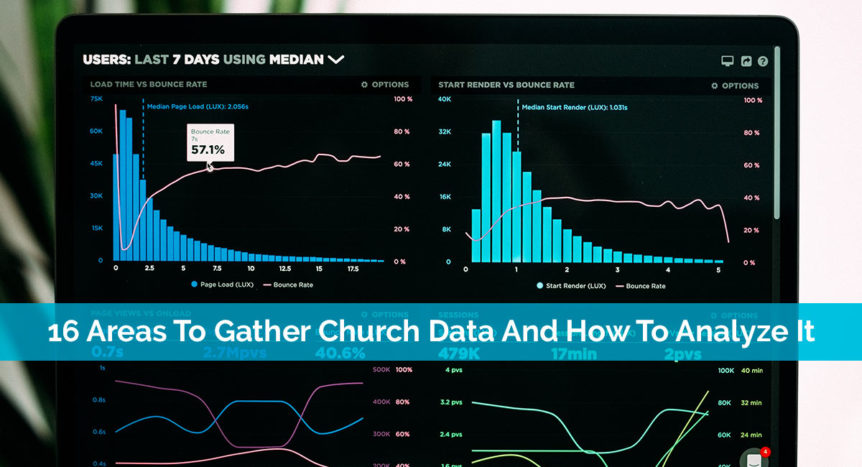While almost every church wants to grow, many don’t realize how important it is to gather church data and learn to analyze it.
Thanks to all the various areas you can gather data in, you’ll discover what strategies are working, which ones are flops and even learn what your major problem areas are.
The good news is all of the data is rather easy to collect. Use it to discover trends, learn more about what your members want and how to grow your church faster.

1. Church Attendance
Church attendance is one of the easiest types of church data to gather. All you need to do is count how many people visit each week. If you want to get more technical, ask members and visitors to sign in. Then, you’ll be able to tell who comes and when.
For instance, if you have 100 members, but 75 show up one week, 60 the next and 80 the third week, you’ll have names to see which members are coming and when. You may discover that a simple schedule change could boost attendance each week.
The key is to study the attendance data over several months. Learn your members’ habits. Some members may only come twice a month while others come weekly. Everyone has their own reasons why they don’t attend every single week.
Talk with your members once you’ve analyzed the data to figure out why attendance patterns exist the way they do. You’ll gain insight into how you can change to increase overall attendance and keep your current members coming back.
2. New Visitor Repeats
How often do new visitors come back? If the percentage is low, this could indicate an issue with your new visitor welcome strategy. While this percentage will never be 100%, you should see at least some of your visitors coming back.
Remember, some new visitors are simply people who are on vacation or staying with family temporarily. If possible, gather new visitor email addresses to ask them about their experience. Ensure them that it’s a one-time message just to help your church improve.
The more data you collect about the new visitor experience and why some don’t return, the easier it’ll be to turn those visitors into members.
3. Social Media Engagement
Every social media network offers analytics tools to help you collect church data about social media engagement. Not sure whether poll posts perform better than Q&A posts? Check your analytics data on the social media platform to see which type of post users interacted with most.
You can learn what types of posts are shared most often, which posts get the most comments and even see which posts helped grow your social media following. All of this is valuable insight you can use to help your church master social media.
For more details on how to use social media analytics tools, Hootsuite and Talk Walker both have great guides for beginners and experts.
4. Volunteering
There probably isn’t a single church that doesn’t want to have more volunteers. Outside of member growth, volunteering is one of the top areas where churches want to grow. However, it’s not always easy.
Even when your church gets volunteers, they don’t always come back for another project. The question is why?
There are several types of church data to collect when it comes to volunteering, including:
- Number of volunteers per type of opportunity
- Repeat volunteers
- Number of hours worked
- Number of volunteers who quit
- Why volunteers leave
- Why volunteers return
- Which leaders retain the most volunteers
All of these data points help your church better understand what motivates volunteers. Create surveys for volunteers to fill out after a project or when they leave during a project. Their names can be kept anonymous if it makes them feel more comfortable.
Using surveys helps you to understand what volunteers like and don’t like. Perhaps it’s simply a leadership issue or volunteers don’t feel connected to the project enough. Making changes to your volunteer strategy could easily boost how many people want to volunteer next time.

5. Creating Leaders
This is a harder metric to measure. However, it’s vital to make sure that your church is creating leaders who can help minister. The right leaders help increase volunteering, church growth and tithing. They also free up a pastor’s time to handle other tasks.
Developing a leadership creation strategy isn’t always easy. Yet, it’s well worth the time and effort. Pay close attention to who volunteers to take charge.
Also, measure which church leaders are most effective at motivating and inspiring others. You’ll find that gathering this data is more difficult, but it’ll help you see who is the best for training new leaders and what the most effective strategy is for creating new leaders in your church.
6. Community Engagement
Church data doesn’t end inside your church. Your local community helps support your church in many ways. Odds are, they donate money during community events, direct new people to your church (even if they don’t attend themselves) and are friends of people who are members.
The more your church engages the local community, the more likely you are to inspire more people to worship. Even if they don’t attend in person, they may follow your church online. This gives you the chance to guide more people on their journey with God.
Count how many people attend community events. Tally up which events are most profitable for your church. Measure growth after events. All of this allows you to focus on hosting the types of events your community prefers.
7. Online Ad Results
If your church invests in online ads, measure the results. Don’t just look at a single campaign, though. Instead, test a variety of different ads. Advertise different things, adjust your target demographic, play with your phrasing and much more.
The reason you gather data here is to ensure you’re making the most of your online advertising budget. Google offers quite a few free tools to nonprofits to help in this area.
Most social media platforms have built-in analytics to help you measure the results and engagement of different ad campaigns. Use these tools to improve your strategy and jumpstart growth.

8. Print Ad Results
Even though digital might seem like the only option, print ads do still have a place. In fact, marketing experts agree that print ads are still valued by many consumers. This applies to churches too.
If you’re already using print ads, measure the results to determine whether you’re using the right strategy. For instance, are flyers or newspaper ads more effective? Which stores lead to the most new visitors?
Much like with online ads, you have to keep gathering data and measuring results to make the most of your ad budget.
9. Time Management
This might seem like an odd area to gather church data, but a more productive church runs more smoothly. This can lead to better growth, happier leaders and better ministry overall.
It’s not always easy to juggle various tasks. Church leaders have a lot to handle, but if they don’t manage their time wisely, many of those tasks are left undone or leaders have to spend extra time trying to finish.
Gather data on how often leaders are interrupted, how long they stay extra hours and how many tasks are left undone. You’ll discover who manages their time well and who may need training to get more accomplished without feeling overwhelmed.
10. Church Staff Productivity
Along with time management, measure productivity. The two are similar and you may choose to only gather church data about one or the other.
The main difference is productivity has much to do with the environment your church leaders are in. For example, if it’s a stressful environment with poor leadership, other church leaders and volunteers might not be as productive as they could be.
Talk to your staff and volunteers about how they feel they could be more productive. Something as simple as adding uplifting music while everyone works could increase productivity, but you won’t know until you measure and analyze the data.

11. Blog Engagement
Your church blog is an invaluable tool for connecting to your members 24/7 and growing your church both online and off. However, are your blog posts really connecting?
Much like with social media posts, measure the overall engagement with your posts. Categorize each post by type to see which types perform better. You should also try to gather data on where blog post visits originated, such as from search engines, email links or social media posts.
Use this data to focus your efforts on better blog posts. Many blogging platforms and website hosts/tools help you to measure this. Google Analytics is also a popular option for measuring everything related to your blog and site.
12. Church Website Visits
Your church website is just as important as your blog. Since new visitors often research churches online first, you want them to be able to easily find details about hours, location, mission and more.
You’ll want to measure your church’s website visits, along with other critical data such as bounce rate, to see where your site can improve. You can use the same Google Analytics tools that you would use with just a blog to measure your church website performance.
Don’t be overwhelmed by the analytics data available. Use it to your church’s advantage to keep improving online.
13. Streaming Views And Engagement
If your church offers streaming, measure the views and engagement. This applies whether you’re using your own website, social media or a third-party platform.
Start by seeing how many people join. Measure how long each viewer stays connected. Remember, connection issues can cause some viewers to disconnect before they want to.
Concerning engagement, measure how many comments and reactions your live stream receives. This isn’t applicable if you don’t have a way for viewers to reach out in real-time.
Finally, measure how many people view the stream after it’s over. This only applies if you offer later viewing.
Much like with any other church data, use the information to improve your stream and market it better.
14. Ministry Program Participation
How many ministry programs does your church have? Do you actually need all of them? It’s easy to get carried away and create a separate ministry group for every age, gender, marital status and interest. However, this can quickly get out of hand.
If you’re a small church with less than 100 members, it doesn’t make sense to try to support 20 ministry groups. Even large churches may struggle with this.
Instead, see whether you need to dedicate resources to numerous ministry groups or if you can combine some of them. If only three people are part of one group, but 24 members attend another group, the first one probably isn’t that effective.
As an alternative, create private Facebook groups for ministry groups you don’t have the resources to host within your church.
15. Sermon Styles
Every pastor has their own sermon style. However, this doesn’t mean pastors can change it up slightly. This is especially true when they start at a new church.
It’s important to gather church data on various sermon styles to see how your members react and engage. A great time to do this is when you’re searching for a new pastor. Have guest pastors try out different styles to see which is the best fit for your church.
If you’re having trouble maintaining members and keeping new visitors, it may be time to ask your pastor to try a different style and tone that’s more engaging.
16. Sermon Themes
While style is important, sermon themes are even more important. Many church attendees leave when they don’t feel the sermons are helping them.
Your members all have specific needs when it comes to following their faith. When sermon themes don’t guide them or reach them, they may even question that faith.
Measure how engaging various sermon themes are by surveying your members, talking to live stream viewers and studying how engaged members are during the sermon. Simply switching themes slightly is enough to drastically increase engagement and retain members.
Does your church have a website to measure online engagement? If not, contact us today to improve your church’s online presence.




